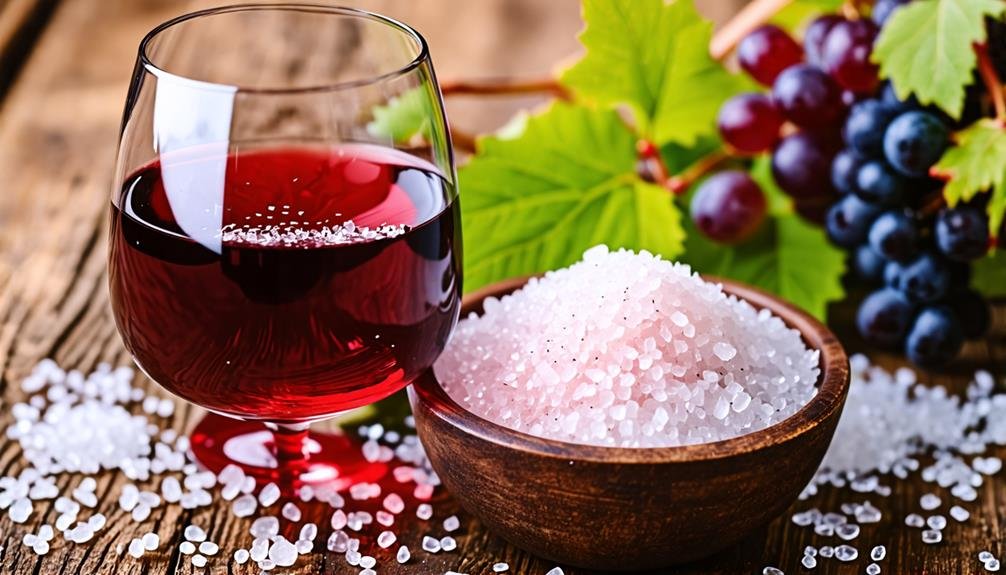Adding a pinch of salt to red wine can truly enhance your tasting experience. This simple addition stimulates your taste buds, revealing hidden umami flavors that you might never notice otherwise. It balances the wine's sweetness and acidity, creating a harmonious sip. Imagine delving into deeper complexities in a favorite Cabernet Sauvignon or transforming an affordable bottle into something extraordinary! Opt for premium sea salt or even a flavored blend to experiment with different profiles. This ancient practice not only enriches enjoyment but also invites adventurous wine lovers to navigate new dimensions. Who knew a sprinkle could offer such delightful surprises? There's much more to investigate!
Ancient Origins of Salt in Wine
The practice of incorporating sodium chloride into vino, dating back to Ancient Rome, showcases a rich tradition aimed at enhancing taste and preservation. In antiquity, ocean water served as a vital component in vinification, acting as an age-old trick that elevated the beverage's profile while prolonging its shelf life. This method was not only practical; it demonstrated an intricate comprehension of how salt can elevate the sensory experience of wine.
Modern red wine suggestions still resonate with this ancient knowledge, as contemporary trials indicate that a dash of salt can amplify the flavors of various wines. Premium sea salt, often sourced from remote locations, is prized for its ability to enhance the intricate notes found in red wine. The addition of salt stimulates taste receptors, harmonizes sweetness with acidity, and reveals subtle savory undertones that might otherwise remain hidden.
As we delve into this intriguing blend of heritage and modernity, we recognize that the ancient ritual of adding salt transcends mere antiquity; it offers a vibrant avenue for exploration in our contemporary wine experiences. Embrace this enduring craft and discover the delightful intricacies it can introduce to your glass.
How to Try This Hack
To explore this flavor-enhancing trick, pour a glass of Cabernet Sauvignon and add a sprinkle of Himalayan pink salt to experience a transformation in taste. This straightforward technique can elevate your enjoyment of wine, introducing a new layer of complexity. Here are some tips for your wine journey:
- Select Your Wine: Pick a Cabernet Sauvignon that you enjoy, especially those that may benefit from enhancement, like budget-friendly blends.
- Add Salt: Sprinkle a bit of Himalayan pink salt or try different salts like Maldon sea salt to discover unique flavor nuances.
- Enjoy the Contrast: Take a moment to taste the Cabernet Sauvignon before and after adding the salt. Observe how the flavors evolve and deepen, uncovering hidden notes that might have been previously unnoticed.
Benefits of Adding Salt

Adding salt to red wine can transform your tasting experience in remarkable ways. It improves flavor perception by awakening taste receptors, creating a delightful balance between sweetness and acidity while revealing hidden savory notes. With just a pinch, you can enhance the general smoothness of the wine, making each sip more enjoyable and memorable.
Enhancing Flavor Perception
Salt enhances flavor perception in red wines, elevating the tasting experience significantly. A small pinch can uncover hidden depths and complexities in your glass.
Here are three advantages of incorporating salt into your red wine:
- Stimulates Taste Buds: Salt invigorates your palate, making each sip more vibrant and pleasurable.
- Unveils Umami Flavors: Adding salt can highlight subtle savory characteristics that may have gone unnoticed, enriching the overall flavor profile.
- Softens Flavor Intensity: Salt can mellow the wine's boldness, making it more enjoyable for those who find certain varietals, like Cabernet Sauvignon or Merlot, overwhelming.
For the adventurous wine lover, experimenting with salt offers a distinctive way to customize your tasting journey. Whether savoring an affordable Malbec or a full-bodied Syrah, salt can transform your experience and reveal new flavor dimensions. So why not try this simple yet impactful technique and discover how it enhances your next glass of red wine?
Balancing Sweetness and Acidity
Integrating sodium into Cabernet Sauvignon not only enhances flavor perception but also plays a significant role in balancing the sweetness and acidity inherent in various wine types. Many varietals, especially those leaning towards the sweeter side, can benefit greatly from this simple addition. A sprinkle of sodium can create a harmonious balance, enabling the natural acidity of the wine to shine while moderating excessive sweetness.
When sodium is included, it enlivens taste receptors, enhancing the overall sipping experience. This subtle modification can convert an overly sweet Merlot into a more well-rounded and pleasurable experience. The chemistry at play is intriguing; sodium helps to mellow bold flavors, making the wine feel silkier and more unified on the palate.
Furthermore, this method is liberating for wine enthusiasts. It enables you to experiment with your preferred bottles, elevating even more affordable labels into something truly delightful. Picture the delight of transforming a plain red blend from Yellow Tail into a memorable experience, simply by adding a dash of sodium. So, why not embark on this flavorful exploration? Give your taste buds the liberty to venture and uncover the delightful balance that sodium can bring to your red wine journey.
Revealing Hidden Notes
A sprinkle of sea salt can unveil hidden savory notes in Cabernet Sauvignon, enhancing the tasting adventure beyond its initial flavor profile. This straightforward addition awakens your taste buds, harmonizing the wine's sweetness and acidity while revealing layers of flavor that may have been overlooked.
To maximize this delightful enhancement, consider the following:
- Experimentation: Try various salts—table salt, kosher salt, or high-quality fleur de sel—to discover which pairs best with your selected wine. Each type offers unique characteristics to highlight.
- Quantity Matters: A light sprinkle is enough; excessive salt can overwhelm the wine's natural essence. Start with a small amount, and adjust based on your taste preferences.
- Wine Selection: This approach works exceptionally well with a range of wines, particularly more affordable options or those that lean towards sweetness. Elevating these bottles can transform your experience, making even an everyday Merlot feel luxurious.
Experiments and Findings
Recent studies by contemporary vintners reveal that integrating sodium into wine can significantly enhance its flavor profile. These pioneering experiments indicate that a modest addition of sodium can deepen the wine's complexity, softening harsh notes and unveiling concealed flavors. Interestingly, wines mixed with a hint of ocean water have gained acclaim for their harmonious and delightful flavors, providing a surprising twist to conventional tasting experiences.
Nevertheless, balance is essential; too much sodium can overshadow the wine's original character. The allure of sodium lies in its ability to stimulate taste receptors, balancing sweetness and acidity while uncovering savory elements that might have otherwise gone unnoticed. This idea fosters a culture of experimentation, motivating wine enthusiasts to explore the transformative effects of sodium in their favorite varietals.
These discoveries resonate with an emerging community of wine lovers who cherish the freedom to personalize their tasting experiences. Whether enjoying a robust Cabernet Sauvignon or a delicate Pinot Grigio, the addition of sodium can lead to delightful discoveries, enhancing your palate and offering a fresh perspective on wine enjoyment. So, why not experiment? Embrace the possibilities!
Varieties of Wine to Enhance

In enhancing your wine experience, the possibilities are thrillingly varied. From hearty reds to refreshing whites, nearly every variety can benefit from a touch of salt, which brings out hidden flavors and harmonizes the complete profile. So, whether you're working with a wallet-friendly blend or a more refined bottle, don't hesitate to sprinkle in a pinch of salt and discover the delightful transformation it brings.
Types of Wine
Different types of wine, including both red and white varieties, can greatly benefit from the addition of salt to enhance their flavor profiles. This simple enhancement can transform even the most affordable bottles into enjoyable experiences. Here are some wines that particularly stand out with a pinch of salt:
- Red Blends: Inexpensive red blends often contain sweetness that salt can counterbalance, revealing richer, more complex flavors.
- Chardonnay: This popular white wine can highlight its buttery notes with the introduction of salt, creating a more luxurious mouthfeel.
- Rosé: A light sprinkle of salt can elevate the fruity and floral characteristics of rosé, making it an invigorating choice for warm days.
The magic of salt lies in its ability to awaken taste receptors, enriching your wine experience. It's an exciting journey of exploration where personal preference is key. Whether you're on a budget or seeking to enhance your favorite varietals, the opportunity to experiment with salt opens the door to endless possibilities. So, pour a glass of your favorite wine, grab some salt, and embark on a flavorful adventure!
Experimenting With Salt
Exploring the enhancement of various wine varieties with salt can lead to a remarkable transformation in taste, making even the most affordable selections more enjoyable. While many may hesitate to add salt to a premium bottle, a small pinch can reveal hidden layers in your glass.
Red varietals, especially those that are overly sweet or lacking depth, can benefit greatly from this simple addition. Imagine how a few grains of Himalayan sea salt can balance the tartness and sweetness, allowing richer savory notes to surface. This method is not exclusive to reds; white varietals and rosés can also experience a delightful boost when complemented with salt, unveiling intricate flavor profiles that might otherwise remain hidden.
The beauty of this experiment lies in its accessibility. Whether you are enjoying a classic Robert Mondavi Cabernet or a modest Barefoot Merlot, feel free to sprinkle in a pinch of salt and take a moment to savor the evolution of flavor. The freedom to explore and personalize your wine tasting experience is what makes this endeavor so thrilling. So, gather your favorite bottles and let your taste buds lead the way!
Tips for Choosing the Right Salt
Choosing the right type of salt can greatly enhance the flavors of your wine, making it essential to consider the source and texture of the salt you select. The specific variety of salt you choose can enrich your wine experience, so keep these tips in mind for a delightful tasting journey:
- Choose Sea Salt: Premium sea salt, such as Maldon or Fleur de Sel, is often favored for its distinctive mineral content, which can beautifully complement the intricate flavors found in red wines. Look for flaky or coarse varieties that dissolve effortlessly.
- Explore Flavored Salts: Consider using salts infused with herbs or spices, like garlic salt or rosemary salt. These unique blends can add an exciting twist to your wine, unveiling new layers of flavor that may surprise your palate.
- Control the Amount: Start with a small pinch; excessive salt can overshadow the wine's natural characteristics. The aim is to enhance, not dominate, so adjust according to your taste preferences.









